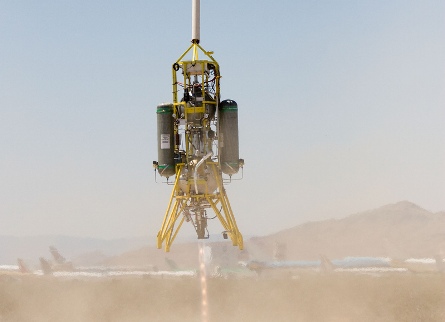NASA is getting closer to near-space with a $475,000 award to two companies developing reusable vehicles for suborbital flight.
Under the public-private partnership dubbed the Commercial Reusable Suborbital Research Program (CRuSR) programme, Armadillo Aerospace and Masten Space Systems will run conduct test flights of their experimental near-space vehicles.
Texas-based Armadillo will get about $225,000 and competitor Masten of Mojave, Calif., will receive about $250,000 to fly their respective vertical take-off/vertical landing (VTVL) rockets.
The flights are to demonstrate the vehicles' ability to provide recoverable launch and testing of small payloads going to "near-space" - usually considered to be anywhere within Earth's atmosphere between 65,000 and 350,000ft. There, a microgravity environment mimics the conditions of space ideal for experimentation, but reusable vehicles do not need an expensive heat shield to return to Earth. The CRuSR programme is aimed at developing commercial reusable transportation to near space for regular, frequent, predictable near-space at a reasonable cost with easy recovery of intact payloads.
 |
|---|
| © Masten Space Systems, Inc. |
Armadillo's Super-Mod VTVL vehicle will make three flights under the CRuSR award - two this fall and one over the winter - from Spaceport America in New Mexico. The first two flights will be to an altitude of approximately 47,520ft and the third to approximately 132,000ft.
The Masten Space Systems' Xaero vehicle will make four flights this winter from the Mojave Air and Space Port in California. Two flights will reach an altitude of approximately 15,840ft and two others will be to approximately 95,000ft with an in-flight engine shutdown. Masten demonstrated an in-flight restart with the Xombie VTVL rocket on 26 May.
The test flight vehicles will carry multiple payloads, says NASA, including NASA Ames flight monitor to document the vehicles' flight environment and a is a "particle agglomeration experiment" from the Space Sciences Lab at the University of California Berkeley, which has also previously taken a trip to the International Space Station. Both launch vehicles also will be modified to mount three antennas for the Automatic Dependent Surveillance-Broadcast (ADS-B) navigation and positioning payload.
"These two awards are just the beginning of an innovative teaming relationship with industry to provide affordable access to the edge of space while evaluating the microgravity environment for future science and technology experiments," says NASA chief technologist Bobby Braun at NASA Headquarters in Washington. "CRuSR represents the sort of government-commercial partnership that will facilitate near-space access at affordable costs."
This spring, the White House committed a $15 million per year investment in CRuSR from 2011 through 2015 to fund research and development of suborbital spacecraft. The space bill, however, is still struggling though the legislative process with the US Congress.
Source: Flight International






















